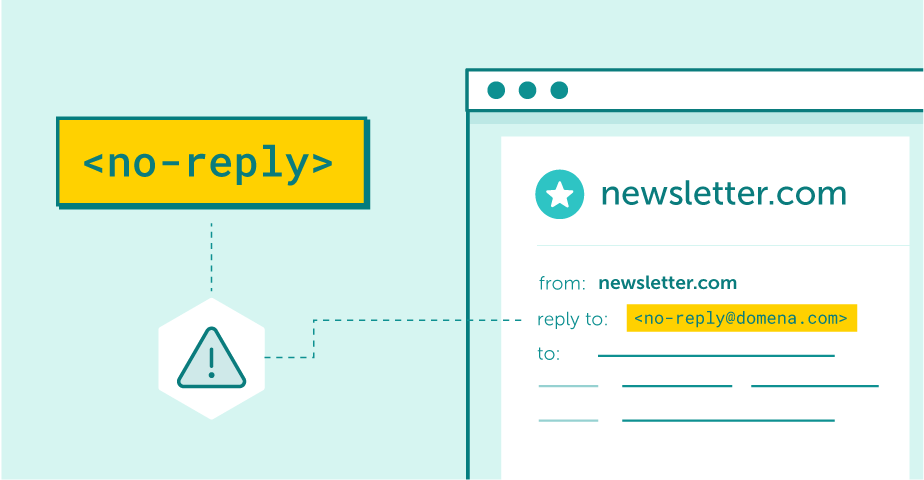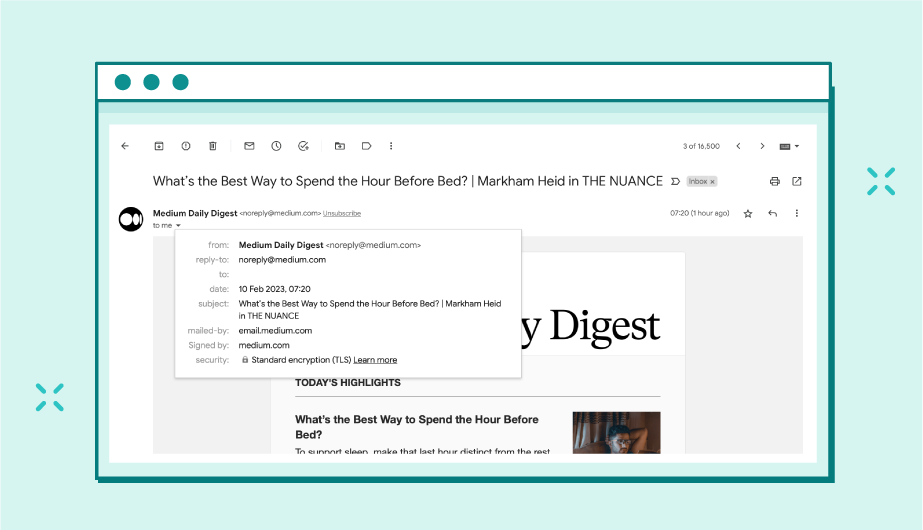Best practices, Deliverability
Best practices, Deliverability
For many businesses, sending emails is an important part of communicating with customers and prospects at every step of the customer journey. When creating an email address for your email marketing campaigns, you may be tempted to use [email protected], thinking that it would be a good way to avoid getting flooded with responses to your emails.
However, you should be aware that communication is about having a dialogue, listening, and exchanging messages. Not only do users naturally expect to be able to reply to an email, but this practice is also viewed negatively by some email service providers and eventually decreases deliverability rates.
This makes no-replay addresses a less-than-ideal choice for business emails, and this is exactly why it is not recommended to use “no-reply” email addresses as the sender of the message.

Noreply email address create a poor customer experience
Join us as we explore this issue in greater detail – only then will you be able to ensure your marketing efforts don’t frustrate customers.
Maximize your email deliverability and security with EmailLabs!
There are several important considerations why we should not use a no-reply email address:
Email communication is, by definition, two-way, so a desirable attitude is one where the brand not only speaks but listens to its customers.
When you use a “no-reply” address for your marketing emails, the message looks like it’s coming from a faceless entity that doesn’t want to hear from them. In such a case, recipients might as well mark it as spam.
When an email is marked as spam, it not only affects the deliverability of that particular message but can also lead to future emails from the same sender being automatically added to a junk folder. This is because most spam filters work by analyzing not only the content of an email but also the behavior of the sender.
A mailbox provider may also blacklist “no-reply” email addresses, which means that any messages sent from those addresses will be automatically blocked. This, of course, will further harm your deliverability rates, which is something you definitely want to avoid.

When you block a sender, messages they send will go to your Spam folder
The whole idea of using email marketing is to reach as many people as possible with your message, so it makes sense that you want your emails to actually reach the inboxes of your recipients.
Unfortunately, that’s not always easy to achieve. Email deliverability is a complex issue, and there are many factors that can influence whether or not a message will be delivered. A sender’s address is one of the contributing factors, and using a no-reply email may reduce the deliverability of emails.
This is especially seen for global email providers such as Gmail, Yahoo, and Hotmail. They evaluate a sender’s reputation based on the responsiveness of users to messages received, i.e. clicks, redirects to other tabs, and email responses.
Do you not allow a reply? The quality of your email communication drops significantly in the eyes of providers then. If you prevent recipients from contacting you and the CTR of your messages is low, you run the risk of decreasing the deliverability and conversion of subsequent email campaigns.
Over the last few years, we have also observed cases of messages from no-reply addresses being marked as spam by some mailbox providers, especially local ones. It is dictated by the use of less advanced anti-spam filters, which, based on simple rules, block the acceptance of e-mails, automatically assuming that such correspondence is not desired by the recipient.

“Blacklisting” is the process of manually marking an email sender as spam.
When an email doesn’t get delivered, it doesn’t matter how well-crafted or relevant your message is – it will never reach its intended recipient. This is why it’s important to use an email address that will maximize the chances of deliverability, and a “no-reply” address is definitely not the best choice in that regard.
Being able to reply to a message is required for effective information flow. This is particularly important for transactional emails, such as order confirmation or shipping notifications, where customers might have questions or need assistance.
Imagine a situation in which a customer has a complaint about the service and processing of a purchase in an online shop. They do not grab the phone to call the hotline but describe the case a few days later when they are asked to give a rating in a separate email.
By not allowing customers to reply to email address, we cut off our way of receiving valuable feedback.
Worse still, in this situation, customers, unable to vent their dissatisfaction in an email reply, will give negative feedback to the shop a few days later when receiving automated responses asking to evaluate the performance of their orders in another email.
The use of a noreply@domain.com says a lot about your brand.

Using noreply addresses a less-than-ideal choice for business emails.
It’s important to understand that people generally like to feel like they are being heard. When they see a no-reply email address, they may feel like their concerns or questions will go unaddressed. It also conveys the message that you’re not interested in hearing from them or that you don’t care about customer feedback.
All this may result in poor customer experience, making them discouraged from further cooperation – and that’s not the best way to build strong customer relationships.
Besides, even though an unsubscribe link is available in emails, which is usually inserted at the very end of a long message, some users choose the easiest solution, i.e. informing about the wish to unsubscribe from the list by clicking on the Reply button.
This is because users are accustomed to the system functions of the mail they use; therefore, if the “reply” option does not work, they are very likely to mark e-mails as spam, which could hurt our reputation as a sender and thus impair the deliverability of our subsequent messages.
If your customers have a strict email filtering system in place, your messages sent from a no-reply email address may never reach their inboxes. However, by adding an address to the Whitelist or contact list, they send a signal that messages from this sender should not be evaluated by spam filters.
Therefore, conducting communication from a “no-reply” address and thus not being able to add such an address to the whitelists may also result in lower deliverability.

Transaction mail received from a “no-reply” address, with no way to respond.
Maximize your email deliverability and security with EmailLabs!
So, what’s the best way to ensure that your emails are actually delivered and that you can collect feedback and answer customer questions effectively? The answer is simple – set up a dedicated email address that will encourage replies.
Instead of using a no-reply email address, use a real email that belongs to a real person. This will show your recipients that there is a human being behind the message and add a personal touch to your communication strategy.
Of course, you don’t have to use your personal email address. If you’re a small business, you might not have a generic support email address yet, but you can create one for general inquiries or even set up an auto-responder that will handle customer requests.
Are you concerned that you will be flooded with irrelevant emails by allowing users to respond?
There are ways to have an effective dialogue with your subscribers while not being bombarded by thousands of autoresponder replies and “out of office” notifications in the case of a large marketing campaigns.
For such mailings, it is useful to sort the automated responses (autoresponders, replies from the server in case of incorrect addresses, etc.) in advance – many comprehensive mailing services allow you to manage the responses directly from the system.
Conducting email correspondence from a no-reply address can affect how your customers perceive your brand, suggesting to them that their voice is not important to us. What’s more, it also affects the delivery rates of your marketing emails.
In times when providers like Gmail and Yahoo support two-way communication, measure the engagement of our recipients and classify messages according to these metrics, it’s worth remembering that it does not just click that matters but whether recipients respond to our emails.
So, let’s not make it harder for them to get in touch, if not for the sake of a “good impression,“, then for the deliverability of our emails, as it can simply be more profitable.
Do you have questions? Contact our team.
We are proud to announce that Vercom S.A., the company behind the EmailLabs project, successfully passed an audit for compliance with the latest ISO/IEC 27001:2022 and ISO/IEC 27018:2019 standards....
Gmail has announced significant changes in the requirements for email senders to maintain a good reputation and proper classification of messages in user inboxes starting from February 1, 2024....
The increasing number of phishing attacks each year, and the projection that this trend will continue to escalate, aren’t likely to astonish anyone. This can be attributed, in part,...
Out of all the things that can go wrong when sending out marketing emails, having your emails end up in the recipient’s spam folder is arguably the most dreaded...
Email Authentication, Security
DMARC is an email authentication protocol that is designed to give domain owners the ability to protect their domain from unauthorized use, commonly known as email spoofing. Spoofing occurs...
With the emergence of the Covid-19 pandemic, many brands have been challenged to adapt in a short period to the changed reality and new consumer attitudes. That meant reorganizing...
Are you frustrated with the constant struggle of your emails getting blocked by Gmail? Have you ever wondered about the reasons behind this issue and, more importantly, how to...
In the ever-evolving landscape of email management, Google has announced an exciting upgrade to Gmail’s summary cards, aimed at improving user experience and streamlining inbox navigation. The latest enhancements,...
Antispam, Best practices, Dobre praktyki
Entering the world of email communication, you’ll encounter many terms that initially seem straightforward and intuitive. However, some of these can be pretty challenging. Accurately distinguishing between them is...
Are you frustrated with the constant struggle of your emails getting blocked by Gmail? Have you ever wondered about the reasons behind this issue and, more importantly, how to...
In the ever-evolving landscape of email management, Google has announced an exciting upgrade to Gmail’s summary cards, aimed at improving user experience and streamlining inbox navigation. The latest enhancements,...
Antispam, Best practices, Dobre praktyki
Entering the world of email communication, you’ll encounter many terms that initially seem straightforward and intuitive. However, some of these can be pretty challenging. Accurately distinguishing between them is...
Attaching a folder to an email may seem complicated at first glance, especially if you’re trying to send multiple files or an entire project’s documents to a colleague or...
Best practices, Deliverability
In today’s digital age, email has become an integral part of our personal and professional communication. We rely heavily on emails to send important messages, documents, and updates. But...
We are proud to announce that Vercom S.A., the company behind the EmailLabs project, successfully passed an audit for compliance with the latest ISO/IEC 27001:2022 and ISO/IEC 27018:2019 standards....
Best practices, Deliverability
Are you struggling to improve the deliverability and engagement of your email marketing campaigns? Look no further than email subdomains. You can protect your root domain and effectively manage...
What is the darknet? Shrouded in mystery for many years and often associated with ominous connotations, the darknet is a part of the internet that evokes curiosity, fascination, and...
A few weeks ago, at Vercom, we began the process of implementing the NIS2 Directive and preparing to meet the requirements of the Digital Operational Resilience Act (DORA). What...